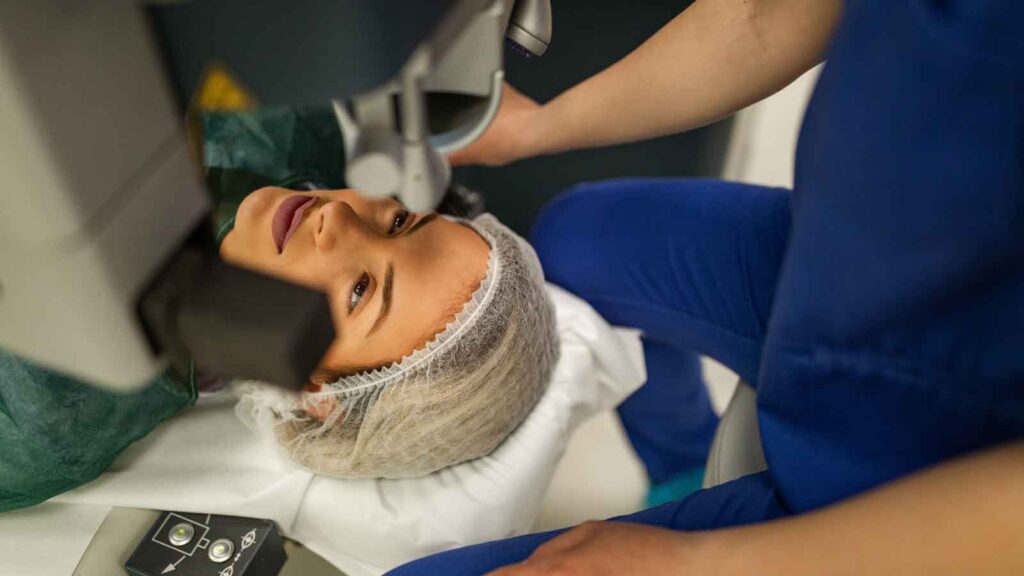LASIK can be the perfect solution if you’re tired of juggling contact lenses or constantly misplacing your glasses. However, figuring out if the timing is right for this life-changing procedure isn’t always straightforward.
When it comes to eye health, age isn’t just a number—it plays a crucial role in determining whether LASIK is the right fit for you. So, is there really an ideal age for comprehensive LASIK eye surgery?
This article will explore how age-related factors can impact your LASIK results and help you decide when the time is right to experience a more transparent, hassle-free vision.
The Biological Basis for Age Requirements in LASIK Surgery
Age will inevitably impact your candidacy for LASIK, affecting it in more ways than you think. Factors like corneal development, vision stability, and aging-related changes affect the surgery’s effectiveness and your recovery afterward.
To understand the ideal age for LASIK, we must look closely at the biology behind our eyes.
Why Eye Maturity is Critical for LASIK Success
Your eyes need to be fully developed for LASIK to succeed. Unlike bones or muscles, the eye matures well into your 20s. While it can be done, performing LASIK too early is not typically advisable as it can lead to complications.
That is because as your eye matures, its shape shifts, and your vision still shifts. Specifically, eyes need time to fully mature so that:
- There is enough corneal tissue to reshape. However, if the patient has an immature eye, the cornea may be thinner or unstable, which could increase the risk of complications.
- We are working with an accurate prescription. A precise prescription ensures no more fluctuations in vision occur and that further enhancements won’t be needed.
- Long-lasting results are better achieved. Mature eyes require fewer secondary procedures as they are less likely to regress and need another corrective procedure.
- Healing patterns are more predictable. Fully developed eyes are more likely to heal consistently, which ensures better post-operative outcomes and recovery.
Why LASIK is Not Recommended Before Age 18
Most ophthalmologists advise waiting until age 18 to undergo LASIK, as younger eyes are still developing. A stable prescription and fully developed corneas are essential for the surgery’s success. Performing LASIK too early can lead to poor outcomes and unnecessary complications.
Some vital factors why LASIK is not recommended before age 18 include:
- Vision instability is typical for those under 18. The eyes continue to grow and change, making it challenging to ensure that the corrected vision will last.
- Frequent prescription changes increase the need for follow-ups. Many patients under 18 may need an enhancement or an additional procedure within a few years, adding cost and inconvenience.
- Increased risk of regression. In relation to the previous point, correcting vision before it’s stable increases the likelihood that old problems will return over time.
- Developing corneas may not respond predictably. Immature corneal tissue can affect the reshaping process, leading to uneven or less effective results.
By waiting until at least age 18, patients significantly improve their chances of achieving stable, long-term vision correction.
Age-Related LASIK Complications After 40
While LASIK is still an option after 40, age introduces additional complexities. Many adults begin to experience presbyopia around this time, a condition that affects the ability to focus on close objects. LASIK can correct distance vision but cannot prevent or reverse presbyopia.
Additionally, older patients may face issues like dry eyes, which can become more severe after surgery. For some individuals, cataracts might also begin to form, eventually requiring lens replacement surgery that could diminish the benefits of LASIK.
However, it is essential to know that despite these factors, many patients in their 40s still achieve excellent outcomes with LASIK, although they must prepare for possible future treatments.
Recovery Expectations by Age Group
Age influences how quickly and smoothly patients recover from LASIK surgery. Younger patients—particularly those in their 20s and 30s—experience faster healing with fewer side effects, such as dry eyes.
Middle-aged patients in their 40s can still expect solid outcomes but may experience slightly longer recovery periods and temporary dryness or discomfort. Older patients might need more healing time and additional follow-ups to monitor for dryness or other age-related issues.
Consulting with an experienced surgeon helps avoid LASIK mistakes by setting realistic recovery expectations based on age. No matter the age, following post-surgery care guidelines ensures smoother healing and maximizes long-term results.
Final Thoughts: Making Your Decision
Choosing the right time to undergo LASIK is about more than age—it involves balancing vision stability, eye health, and lifestyle needs. Whether in your 20s, 40s, or beyond, correctly timing the surgery ensures the best results and a smoother recovery. A personalized consultation with a professional surgeon is the best way to determine if now is the right time for you.
At Saddleback Eye Center, we specialize in providing expert guidance and care, helping you decide if LASIK fits your needs today. Call us to schedule a consultation, and let us help you see life.




